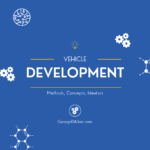Creating New Vehicle Function – Feature Architecture: A Holistic Approach

Crafting Feature Architecture
Introduction - Feature Architecture
In the dynamic realm of automotive engineering, the efficacy of a vehicle hinges on its array of functions, available through the Feature Architecture developed for each function. Consequently, whether pertaining to propulsion, maneuverability, or occupant safety, these functions are pivotal in defining a vehicle’s design. Embedded within its architecture, each Feature delineates the vehicle’s behavior, components, and performance. Therefore, crafting these Feature Architectures requires meticulous planning, encompassing system definitions, subsystem responsibilities, and performance validation. Engineers drive automotive innovation by mastering this process, yielding vehicles that excel in functionality and performance.
Vehicle Feature definition: It is a collaboration of the Vehicle mechanical, electrical and software elements – belonging to different subsystems with a specific goal to perform a defined vehicle level function(s). Example: Front Collision Feature – Provide Occupant protection during Collision.
Reference to Passive Safety Features: https://georgedallen.com/evolution-of-occupant-safety-systems-in-the-vehicle-development/
Feature Architecture Development
At the heart of this process lies the intricate interplay of physical interfaces, data handling mechanisms, and verification protocols. Furthermore, engineers decompose high-level requirements to allocate responsibilities to systems and subsystems, laying the foundation for seamless integration and performance optimization. Moreover, clear definition of the intended function facilitates simulations and tests, guiding development towards verifiable requirements on the vehicle assembly level.
System(s) Development
Vehicle System Definition: It is a collaboration of the Systems mechanical, electrical and software elements – belonging to different subsystems with a specific goal to perform a defined System level function(s). Example: Front Airbag Management System – Provide Occupant protection during Collision, when necessary
System development involves translating requirements into clear definitions for subsystems, encompassing design elements and algorithms. In addition, this clarity aids sourcing, manufacturability, and integration of mechanical, electrical, and software components, ensuring intended performance through verification activities.
Consequently, the complete developed documentation will include the System Requirements, Design and Process Failure Modes Engineering Analysis, and Validation plan.
Subsystem - Readiness and Availability
Vehicle Subsystem Definition: It is a collaboration of the mechanical, electrical and software elements. In case of advanced sensors: usually an ECU Processor with an array of sensors, with a specific goal to perform a defined Subsystem level function(s). Example: Front Airbag Subsystem – Deploy, when commanded.
Subsystem usually is “off the shelf” technology already developed for the known subsystem level requirements, often assuming the higher level requirements due to the previous experience and Government regulations. This necessitates Integration, with thorough verification in the new Vehicle specific application. This also should lead to the thorough re-examination of the subsystem capabilities related to the Vehicle level performance requirements, as well as all of the interfaces.
Consequently, the complete developed documentation will include the Subsystem Requirements, Design and Process Failure Modes Engineering Analysis, and Validation plan.
Verification and Validation
The Vehicle level Feature (function) performance and adherence to benchmark standards is insured through simulations and rigorous testing, propelling innovation forward. Each Subsystem’s verification and testing activities throughout the vehicle development cycle should confirm the performance to the Vehicle level intended functionality.
Referencing Virtual Development: https://georgedallen.com/virtual-development-embracing-tomorrow-today/
Referencing “Virtualization” definition: https://en.wikipedia.org/wiki/Virtualization
Conclusion
Successful implementation of Feature Architecture for advanced sensor functions on the vehicle assembly level necessitates a holistic systems approach. Therefore, Systems Engineering methodology is a must for assemblies with complex sensor functions. Consequently, it applies to the Vehicle and Occupant Safety Features and Risk Mitigation strategies. In addition, it includes development and verification processes and cost management. It applies to conventional and autonomous Vehicles.
Reference to Systems Engineering Method: https://georgedallen.com/systems-v-model-strategy-in-automotive-design/
About George D. Allen Consulting:
George D. Allen Consulting is a pioneering force in driving engineering excellence and innovation within the automotive industry. Led by George D. Allen, a seasoned engineering specialist with an illustrious background in occupant safety and systems development, the company is committed to revolutionizing engineering practices for businesses on the cusp of automotive technology. With a proven track record, tailored solutions, and an unwavering commitment to staying ahead of industry trends, George D. Allen Consulting partners with organizations to create a safer, smarter, and more innovative future. For more information, visit www.GeorgeDAllen.com.
Contact:
Website: www.GeorgeDAllen.com
Email: inquiry@GeorgeDAllen.com
Phone: 248-509-4188
Unlock your engineering potential today. Connect with us for a consultation.


